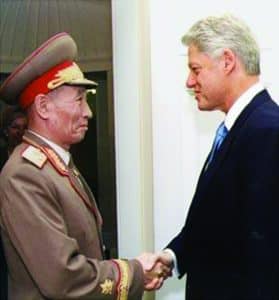In 2004, the Irish government was responsible for 7,959 tons worth of food aid being sent to North Korea. Back in 1999 meanwhile, at a time when the supposedly existential threat posed by the ‘irrational’ North Korean regime was felt almost as acutely as it is today, the Great Satan itself sent over 600,000 tons of the stuff to the so-called Hermit Kingdom.
These figures from the World Food Programme illuminate a number of points that can transcend the myopic, a-historical coverage which prevails in relation to the current crisis. On the one hand, it offers a useful reminder of the fact that North Korea is a country, not only of an ossified leadership class, but of 25 million people, whose recent history includes a ravaging famine among innumerable other hardships, both natural and political. Furthermore, they remind us that the DPRK is a part of the world community just like any other country, and not merely a cartoonish caricature of isolated despotism. A member of the UN since 1991, much of the disagreement has arisen from differing interpretations of the North’s international obligations, rather than the Kim regime merely limbering up every few months to hector the West from the sidelines.
Is it all too far gone? The recent trans-Pacific pissing contest between the rulers of North Korea – and its quiescent 25 million population, and the US – still flabbergasted by Trump, can’t have reassured anybody that the chance of global nuclear annihilation is zero. While the sheer scale of the American deterrent, and the assumed basic instinct for self-preservation on the part of the Koreans would suggest that the situation is a good deal more stable than it would appear, a catastrophic conflagration can’t be ruled out. American analysts estimate that North Korea may be able to strike anywhere on the US mainland with ease within two years. You wouldn’t bet your house against a future clamour for some ‘tactical pre-emption’ in Washington.

Another war would almost undoubtedly be cataclysmic, not least for the Koreans themselves. America would be well within its capabilities to turn the country into, as Colin Powell put it in 1995, “a charcoal briquette”.
Toward the end of the first Korean war in 1951, Emmet O’Donnell Jr., chief of the Bomber Command in the US Air Force, told Congress that the entire peninsula was “a terrible mess. Everything is destroyed. There is nothing left standing worthy of the name”. Hundreds of thousands of civilians had been killed. In this context, it becomes a little clearer that, however morally indefensible, the DPRK’s nominally Stalinist regime is acting in something approaching a rational manner: promoting “an intense devotion to self-sufficiency, sovereignty, and self-defense as the touchstones for all rhetoric and policy”, to quote a 2000 US policy review on the matter. When should the situation have been resolved? A good guess would be at some point in the 1990s, when the United States came as close as it ever has to normalising relations and achieving a de-escalation, and more importantly before North Korea had managed to actually develop a nuclear arsenal.
In 1993, eight years after signing up to the Nonproliferation Treaty (NPT), North Korea announced its departure from it, prompting the first of the current breed of crises. The negotiations which followed produced an ‘Agreed Framework’ between the DPRK and the US. Reading the document in the context of the current belligerence is remarkable. To put a stop to North Korea’s generation of weapons-grade plutonium, it was agreed to shut the country’s graphite-moderated reactors and replace them with light-water reactor (LWR) plants, which an American-led consortium (KEDO) was to build. It was agreed that “within three months…both sides will reduce barriers to trade and investment” and “work together for peace and security on a nuclear-free Korean peninsula”. Hardly the language of two powers locked in intractable conflict. Both sides cheated on the agreement to a greater or lesser extent, with sanctions being imposed by the US within a couple of years in response to missile testing by the Koreans. KEDO was shut down in 2006. In 1999, William Perry travelled as an American envoy to North Korea for talks. The next year, Kim Jong Il’s second-in-command, Jo Myong Rok, visited Washington. Speaking on a New York Times podcast recently, Perry stated that at this point, it was within America’s power to reach an agreement, only for the election of George W Bush months later to change the tone completely, with his apprehension of an axis of evil, and scuttle the next decade of potential progress.
Perry furthermore pointed out that things have only become exponentially harder in the interim. In the 1990s, all North Korea had to give up was a symbolically significant right to develop a nuclear arsenal. Now, that arsenal exists, and a cottage industry of analysts is dedicated to figuring out what it’s capable of. As always, the best strategy is for the administrations to shut the hell up, and start talking some sense to one another. There are still people alive in Korea who remember the results of the alternative.